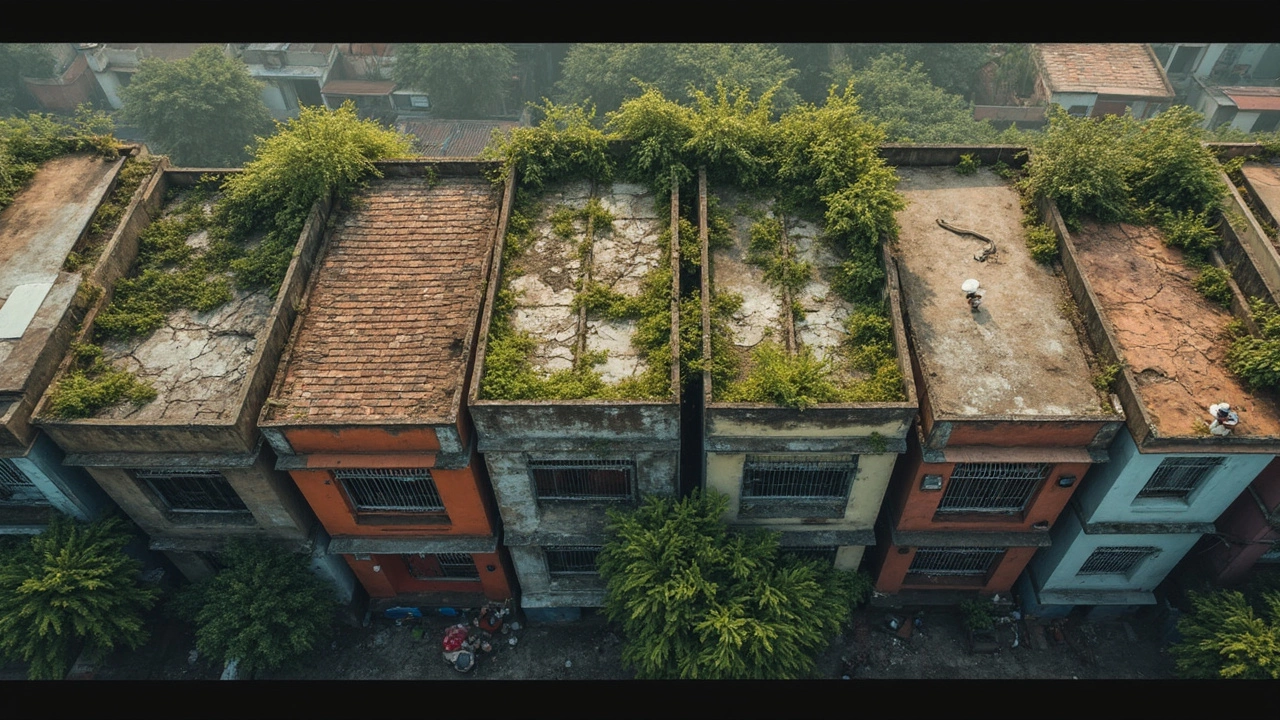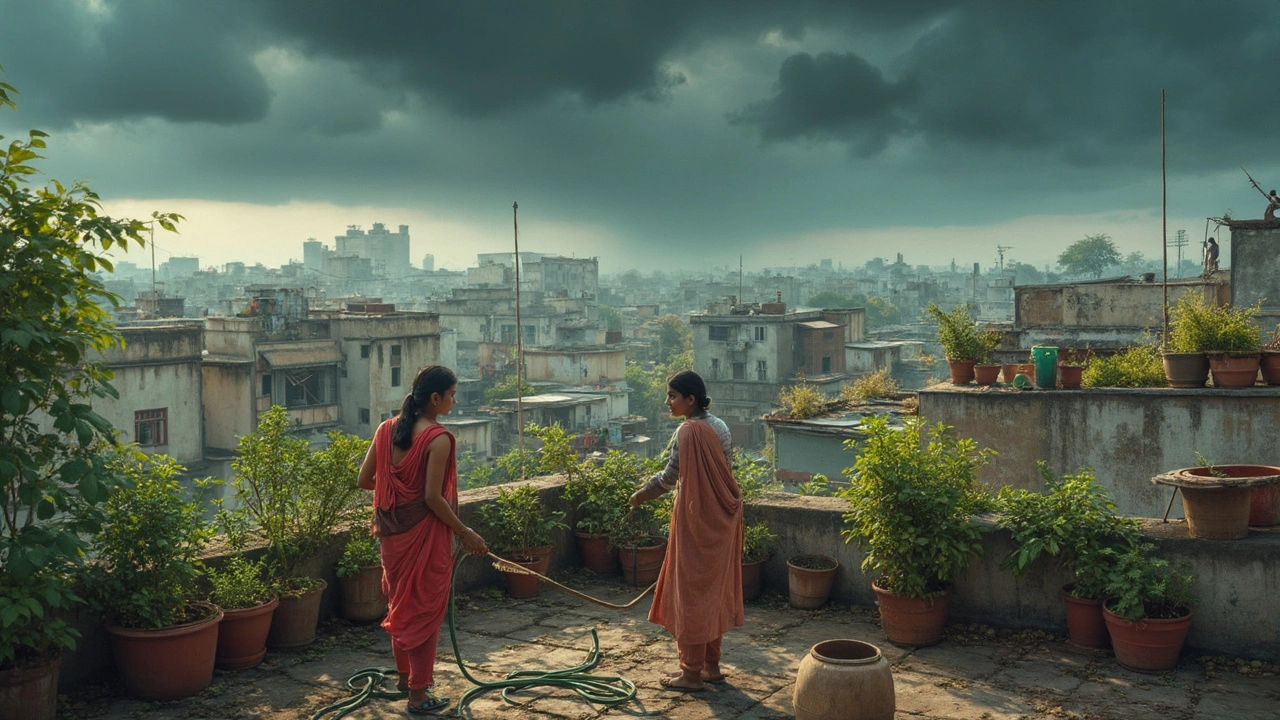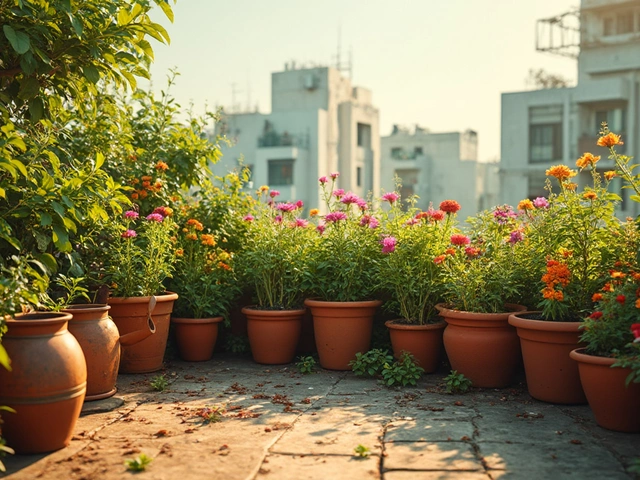Terrace gardening looks amazing on Instagram, but let’s be real: it’s not all homegrown basil and sunset dinners. The cons? They catch a lot of new gardeners off guard. If you’re thinking about starting a garden on your terrace house, knowing the downsides can actually save your sanity—and your money.
First thing you’ll notice: these spaces are usually tight, so every square foot counts. Plants start bumping elbows (leaf to leaf?) way faster than you think. Once you try to squeeze in that extra tomato plant, things can get messy.
And, before you drop bags of soil on your rooftop, did you ever wonder if your terrace can actually hold that weight? Most people forget to check this and end up with leaks or even dangerous cracks. There’s more to it than throwing down a few pots and calling it a day.
- Limited Space Hazards
- Weight and Structural Limits
- Dealing With Weather
- Maintenance Headaches
- Neighbor Issues and Privacy
- Safety Concerns
Limited Space Hazards
Here’s where things get tricky: Most terrace gardens max out at under 200 square feet, especially in cities. This tiny footprint means you’re always making trade-offs. Want to plant squash or pumpkins? Sorry, their sprawling vines take up way too much room. So, you get really good at playing Tetris with your pots.
The space squeeze isn’t just about less room for plants. You’ll also have to find spots for a compost bin, storage for tools, and walkways—unless you plan on tiptoeing through your own jungle every time you water. And over-crowding brings headaches like poor air flow, a spike in pests (because bugs love a packed house), and more diseases spreading from plant to plant.
Many folks try to go vertical to beat the space problem. While vertical gardens look cool, they also need sturdy support and regular checks—imagine a strong wind knocking down your tower of grow bags. Plus, only certain crops thrive this way; root veggies need deeper soil than you’ll get from most planters on walls or railings.
For reference, here’s a quick look at typical terrace garden sizes in popular cities:
| City | Average Terrace Size (sq. ft.) |
|---|---|
| Delhi | 100-250 |
| London | 80-200 |
| New York | 75-150 |
If you’re serious about terrace gardening, make a list of your must-grow plants and sketch out your space first. Be honest about what fits and what doesn’t. A successful terrace garden is less about quantity and more about quality—choose the right crops, leave room to move, and avoid the headache of a plant pile-up. Sometimes, less really is more up here.
Weight and Structural Limits
Here’s something people barely talk about: terrace houses were rarely built for heavy loads. The minute you bring in planters, wet soil, water, maybe even a small seating set, you’re putting a lot of force on the roof. That’s a major risk. If you ignore the limits, you could cause leaks, cracks—or, in the worst case, real structural damage.
Let’s run some numbers. Wet soil weighs about 75 to 100 pounds per cubic foot. Add ceramic planters at 15 to 30 pounds each (empty), and, suddenly, your ‘light’ garden is more like a gym with plants. Even lightweight plastic pots can add up if you fill the space. Some rooftop slabs are only built to handle about 40 pounds per square foot, but a packed garden can easily go over that.
| Item | Weight (average) |
|---|---|
| Wet soil (1 cubic foot) | 75-100 lbs |
| Ceramic pot (medium) | 15-30 lbs |
| Large planter + soil | 100-150 lbs |
Before you start any terrace house garden, check the building's load-bearing capacity. It’s not a guesswork job. Ask your housing association, or look up your house’s blueprint if you have it. If you’re renting, get your landlord to confirm what’s safe. And, if in doubt, consult an engineer. No one wants a garden that comes with a repair bill.
Try using lighter materials wherever you can—like plastic pots or vertical planters. And if you set up raised beds, keep them small and well-spaced. Grouping everything in one spot spreads the weight unevenly and invites trouble. Keep it spread out, and leave enough walking space between planters.
Dealing With Weather
Terrace houses get more than their fair share of weather drama. Plants on rooftops face everything full force—wind, rain, heat, and cold hit a lot harder up there than at ground level. That means, when you’re figuring out terrace gardening plans, you can’t skip weather prep unless you like watching your seedlings shrivel or fly away.
Wind, for starters, is a real pain. It can literally blow pots over and snap fragile plants fast. If your terrace is at least three stories up, expect gusts over 30 km/h during storms, which is way rougher than what ground-level gardens face. You’ll need windbreaks—think mesh screens, sturdy railings, or tall, dense plants—to give your green friends a fighting chance.
Sun exposure is another biggie. Terraces get blasted with sunlight—sometimes all day long. This can fry leaves and dry soil out so fast. If your city gets 35°C (95°F) days in summer, rooftop pots will need watering twice as much as backyard gardens. Consider shade cloths, light-colored containers (they reflect heat), and self-watering systems. You’ll thank yourself when your lettuce isn’t wilting by noon.
Heavy rain brings its own issues: drainage is a must. Without decent drainage, pots can drown roots or cause nasty leaks into the rooms below. If you see puddles after a decent rain, that’s a red flag to fix up your terrace surface, maybe with sloped tiles or better water runoff channels.
Winter isn’t cozy, either. Rooftop gardens lose heat faster—with concrete floors pulling warmth away at night. In frosty areas, containers freeze up, cracking clay pots and killing roots. An insulating layer (old blankets under pots, bubble wrap around plant containers) can help. If possible, pick hardy plants or bring sensitive ones indoors before the cold hits.
| Weather Factor | Terrace Impact | Pro Tip |
|---|---|---|
| Wind | Often stronger and more damaging | Add windbreaks, use heavier pots |
| Sun | All-day exposure, higher heat | Use shade cloth, water more often |
| Rain | Flooding risk, poor drainage | Check and improve water runoff |
| Cold | Fast heat loss, root freezing | Insulate pots, use hardy plants |
Weather on the terrace means staying alert. Check local weather apps for wind and UV warnings. If a bad storm’s coming, stash lightweight pots indoors or in sheltered corners. There’s no off-season for watching the skies when your garden’s up top.

Maintenance Headaches
If you think terrace gardening just means watering some plants every other day, think again. Up on a terrace, you’ll deal with a whole bunch of unique chores that most backyard gardeners never face. Stuff breaks faster, dirt dries out quicker, and that once-cute collection of pots can turn into a full-blown mess in a month.
Let’s talk watering. Because of direct sun and wind, your terrace garden will dry out way faster than any ground-level plot. According to a 2023 report from the Urban Gardening Network, terrace soil can lose moisture up to 50% faster during summer heatwaves. Forget just skipping a day—miss a morning in July, and your tomatoes might be toast.
Now, if you have a lot of pots and planters, you’ll realize they attract pests—often more than you’d expect in a traditional garden. Slugs, fungal gnats, and spider mites love a crowded rooftop. Plus, things like leaves and plant debris have nowhere to go, so you’ll always be sweeping or picking up.
Regular checks are a must, not just for the plants but for the structure itself. Water leaks are super common, especially if drainage isn’t perfect. One small clog can lead to water backing up and seeping into your ceiling. Here’s what a typical monthly maintenance list might look like for a terrace gardener:
- Check all drainage holes and clean out clogged ones.
- Look for any cracks or leaks on the terrace surface.
- Replenish soil or compost—terrace pots lose nutrients quickly.
- Inspect plants weekly for signs of pests and diseases.
- Prune dead branches and clear plant debris.
- Wipe down surfaces to prevent buildup of dirt and algae.
Wondering how the work stacks up? Here’s a quick table comparing terrace maintenance with regular outdoor gardening:
| Task | Terrace House | Backyard Garden |
|---|---|---|
| Watering frequency (summer) | Daily or twice daily | 2-3 times a week |
| Drainage cleaning | Monthly | Rarely needed |
| Surface cleaning | Every week | Occasional |
| Pest checks | Weekly | Bi-weekly |
| Soil replenishment | Monthly | Every season |
So, before you get caught up chasing a rooftop gardening dream, get ready to handle some real terrace house headaches. Once you fall behind, the mess piles up fast.
Neighbor Issues and Privacy
Sharing space in a terrace house can turn into a headache when your gardening plans clash with your neighbor’s comfort. Rooftop gardens might bump into shared walls, short dividers, or just plain nosy next-door folks. That dream veggie patch? It sometimes means neighbors peering right into your chill zone or the smell of fertilizer wafting into their breakfast window.
The most common friction points for terrace house gardeners are:
- Noise: Even basic gardening can get loud—dragging pots, running a hose, or chatting with visiting friends. Thin walls? That’s your neighbor’s business in seconds.
- Smells: Fertilizer, compost, and wet soil don’t always smell like roses. In hot weather, these odors travel far and fast.
- Blocked Light: Big plants or screens might shade a neighbor’s window right when they need sunlight the most. Expect complaints if your tomato jungle goes overboard.
- Water Runoff: Over-watering can drip through poorly sealed terraces or shared flooring, leading to fights over leaks and mildew.
One UK survey in 2023 found that 38% of rooftop gardeners in terraced homes reported a dispute with neighbors in the first year. That’s more than one in three running into some sort of drama—usually about space, privacy, or water spills.
| Common Issue | % of Gardeners Affected |
|---|---|
| Noise Complaints | 22% |
| Privacy Concerns | 31% |
| Water Leakage Disputes | 18% |
| Blocked Light | 12% |
Want to avoid constant arguments? Keep neighbor relations smooth with a few simple steps:
- Chat first—let your neighbors know your plans and listen to their concerns.
- Stick to low-maintenance, less-smelly soil mixes and fertilizers.
- Use privacy screens made of bamboo or tall pots to block sightlines, but keep them modest so you don’t block anyone’s light.
- Check where water runs when you water your plants; drip trays and waterproof matting work wonders.
- Limit noisy chores to reasonable hours—no pruning marathons at sunrise.
Small fixes and a bit of respect usually keep things friendly. Ignore it, though, and your garden could be the reason for cold shoulders and endless complaints.
Safety Concerns
Let’s talk about what nobody really brings up when they post those dreamy terrace garden pictures—safety. Sure, terrace gardening is fun, but there’s a real risk factor up there, especially in crowded cities. For starters, open railings and ledges can be a serious danger for kids and pets. One accidental trip or a chase after a runaway ball can go horribly wrong. If your terrace doesn’t have proper railing at least 42 inches high, you need to think twice before turning it into your afternoon hangout.
Believe it or not, slips and falls are a leading accident in terrace spaces. According to a 2024 housing safety report from the Urban Living Institute, nearly 18% of reported household accidents on terraces are caused by wet or uneven flooring, especially right after watering plants or during rain.
Carlos Mendez, a city safety officer, once said: “People underestimate how fast accidents happen on rooftops. One minute you’re moving a pot, the next second, someone’s at risk.”
If you’re into DIY, beware of electrical wires too. Many terraces have outdoor lighting or power connections for pumps and fountains. Exposed wires near water sources can get you zapped, so stick to outdoor-rated extension cords and always double-check for GFCI-protected outlets.
And here’s something gardeners don’t usually plan for: emergency access. Imagine your terrace gets blocked by cluttered furniture or big planters. Not only is this a pain in a hurry, but firefighters say that blocked exits are one of the biggest issues when they respond to calls involving rooftop areas.
- Install slip-resistant mats, especially near doors and water points.
- Check that your railing meets your city’s code (usually 42 inches in the US, but check your local rules).
- Keep a clear path to the door at all times—no squeezing around oversized pots or furniture.
- Use weatherproof covers for all outdoor plugs and wires.
| Safety Risk | Yearly Incident Rate (2024) |
|---|---|
| Slips and Falls | 18% |
| Electrical Hazards | 6% |
| Blocked Emergency Exits | 7% |
| Child/Pet Accidents over Railings | 4% |
Bottom line: enjoying your terrace house garden isn’t just about pretty flowers. Play it safe, run a quick checklist, and don’t skip on stuff like non-slip floors and kid-proof fences. Safe spaces make for happy gardening.




